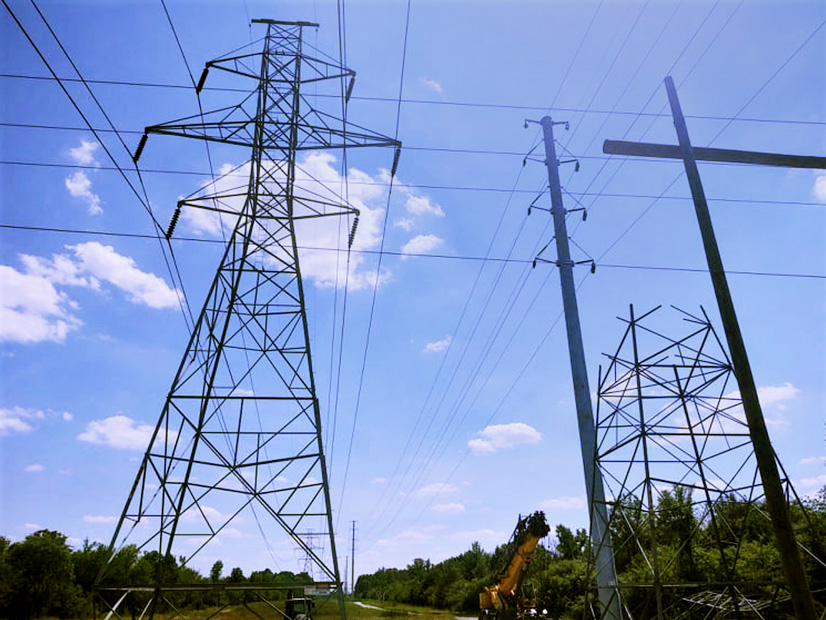MISO’s first version of its 2022 Annual Transmission Plan (MTEP 22) portfolio and will cost $3.3 billion, staff said during the first of a series of subregional planning meetings this week.
The figure is a tick higher than 2021’s package, which slightly exceeded $3 billion and was approved by the Board of Directors in December. (See MISO Wraps Annual Transmission Package.)
The draft MTEP 22 spending breaks down to $611 million worth of baseline reliability projects, $172 million in generator interconnection projects, and $2.5 billion worth of “other” projects, the catch-all classification the RTO uses for projects that address either load growth, aging equipment or other reliability needs.
The grid operator will perform independent analyses through May on the project recommendations to determine whether it finds the same issues that transmission owners identified. Staff will meet with the TOs over any discrepancies.
In August, MISO will release a clearer picture of the recommendations. They will be updated through early December, when the board will take up the transmission planning package for consideration.
The RTO won’t conduct market congestion planning or special economic planning studies this year, leaving those assessments to its ongoing long-range transmission plan. That planning effort might produce its first project approvals for the Midwest in June. (See MISO Promises Long-range Tx Project Reveal Soon.)
“For this year, the economic planning is incorporated into the long-range transmission plan,” said Thompson Adu, transmission expansion planning senior manager.
Transmission planning is more important than it’s ever been in MISO, which has a packed generation interconnection queue comprised almost exclusively of renewable generation and battery storage.
The queue currently has 856 projects totaling 134.3 GW, about 10 GW higher than the system’s current summer peaks. Last fall, developers’ requests to join the system pushed the queue to a 153-GW high, crushing all previous records. (See MISO Warns Queue Won’t Stay at 150-GW High.)
The RTO’s Central region of Illinois, Indiana and northeastern Missouri is responsible for 52 GW of potential generation, much of it solar, spread across more than 300 active projects. Network upgrade costs for just the projects from the 2018 and 2019 cycles, excluding affected system upgrade costs, have been estimated at more than $2 billion.
“Especially in the Central [region], we see the largest number of solar, storage and hybrid projects,” MISO engineer Forrest Tingo said.
MISO South accounts for more than 200 active projects, representing 36.5 GW. The South’s 2020 cycle of generation requests faces $759 million of network upgrades before they can connect to the system.
Clean Grid Alliance’s Natalie McIntire asked whether the region is experiencing costly network upgrades comparable to those of the MISO West planning region, where upgrades come at too steep a cost for most generation developers to proceed. The West’s collection of generation hopefuls in the queue are currently burdened with almost $1.8 billion in estimated network upgrade costs.
Staff said the South’s upgrade costs are trending higher simply because of the number of projects.
Year’s First Expedited Requests Approved
MISO also recently authorized five expedited transmission project reviews in Arkansas, Louisiana, North Dakota and Kentucky.
Staff found no adverse impacts after studying two new substations in northeastern Arkansas and southwestern Louisiana.
Entergy Arkansas has requested to build the Sandy Bayou 500/230-kV substation along the existing Driver-to-Shelby 500-kV transmission line to serve up to 550 MW of new industrial load. The utility hopes to have the $91-million substation in service by June 2024 and said work should begin immediately outside of the MTEP 22 cycle. The substation will be located near the Arkansas-Tennessee border.
Asked whether the Arkansas project is connected to Memphis, Light, Gas and Water’s possible migration from the Tennessee Valley Authority to MISO, staff said no. (See Memphis Moves Closer to Breaking from TVA.)
Memphis recently received bids from more than 20 companies hoping to provide alternative energy sources to the city. Should the city become a MISO member, it would need new transmission links to the system.
The RTO will conduct its next board meeting in Memphis this March. The grid operator has historically held its spring Board Week in New Orleans, but staff said the city’s meeting venues are fully booked.
Southern Renewable Energy Association’s Simon Mahan noted during Tuesday’s South subregional planning meeting that the new substation will be situated near a possible long-range transmission line in MISO South. He asked whether the substation would supplant the need for long-range transmission in the region.
“It’s too early to say how it affects it,” MISO’s Bill Kenney responded.
Cleco’s request for the $15-million Cole substation on an existing 230 kV line in Louisiana drew less stakeholder interest. The utility said the project will address new industrial customers and is estimated to be in service by October 15.
The new substations will not be open to competitive bidding because they’re considered load-growth category projects.
MISO also recommended expediting two requests for transformer upgrades from American Transmission Co. in eastern North Dakota and from Michigan Public Power Agency in western Michigan. Both said load growth required that the projects begin ahead of the MTEP 22 cycle.
Staff will discuss its approvals based on its reliability analyses during the March Planning Advisory Committee meeting.
Kentucky utility Henderson Municipal Power and Light (HMPL) requested the fifth expedited project, a reroute of four 69-kV transmission lines in northwest Kentucky to make way for highway construction. The municipal utility expects the project to cost about $3.8 million.
MISO said HMPL plans to complete the project by the end of June, five months before MTEP 22 receives a vote before the board.
MISO engineer Andenet Leyew said during a Jan. 19 Central Technical Study Task Force meeting that staff didn’t uncover any adverse reliability impacts when analyzing the project. He said the RTO will allow the project to move ahead out of the usual annual cycle, though it will still be considered part of MTEP 22.




